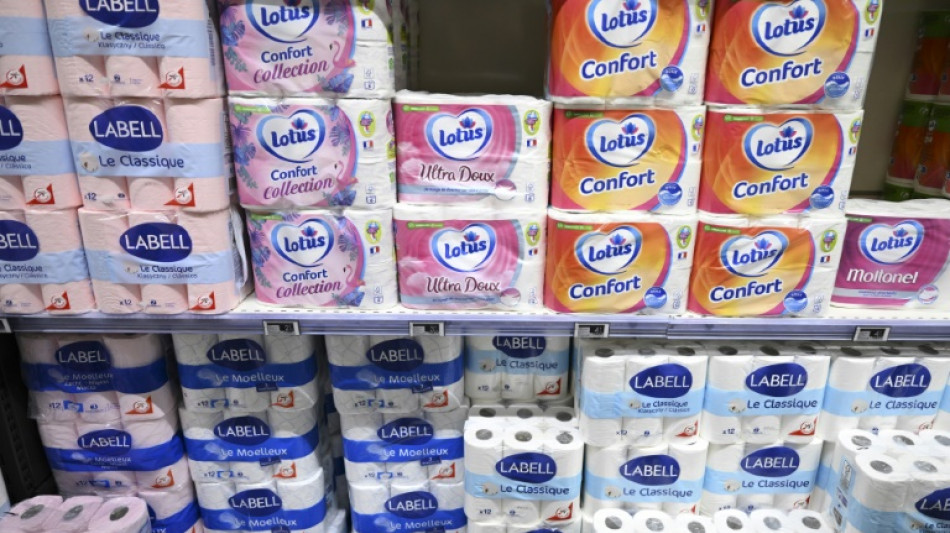
-
 Kosovo players walk off in Romania after 'Serbia' chants, game abandoned
Kosovo players walk off in Romania after 'Serbia' chants, game abandoned
-
Kosovo players walk off in Romania game after 'Serbia' chants

-
 Lame-duck Biden tries to reassure allies as Trump looms
Lame-duck Biden tries to reassure allies as Trump looms
-
Nervy Irish edge Argentina in Test nailbiter

-
 Ronaldo at double as Portugal reach Nations League quarters, Spain win
Ronaldo at double as Portugal reach Nations League quarters, Spain win
-
Fitch upgrades Argentina debt rating amid economic pain

-
 Trump picks Doug Burgum as energy czar in new administration
Trump picks Doug Burgum as energy czar in new administration
-
Phone documentary details struggles of Afghan women under Taliban

-
 Ronaldo shines as Portugal rout Poland to reach Nations League last-eight
Ronaldo shines as Portugal rout Poland to reach Nations League last-eight
-
Spain beat Denmark to seal Nations League group win

-
 Former AFCON champions Ghana bow out as minnows Comoros qualify
Former AFCON champions Ghana bow out as minnows Comoros qualify
-
Poland, Britain reach BJK Cup quarter-finals

-
 At summit under Trump shadow, Xi and Biden signal turbulence ahead
At summit under Trump shadow, Xi and Biden signal turbulence ahead
-
Lebanon said studying US truce plan for Israel-Hezbollah war

-
 Xi warns against 'protectionism' at APEC summit under Trump cloud
Xi warns against 'protectionism' at APEC summit under Trump cloud
-
Nigerian UN nurse escapes jihadist kidnappers after six years

-
 India in record six-hitting spree to rout South Africa
India in record six-hitting spree to rout South Africa
-
George tells England to prepare for rugby 'war' against Springboks

-
 Pogba's Juve contract terminated despite doping ban reduction
Pogba's Juve contract terminated despite doping ban reduction
-
Ukraine slams Scholz after first call with Putin in two years

-
 Michael Johnson's Grand Slam Track series to have LA final
Michael Johnson's Grand Slam Track series to have LA final
-
Kagiyama, Yoshida put Japan on top at Finland Grand Prix

-
 Alcaraz eyeing triumphant Davis Cup farewell for Nadal after ATP Finals exit
Alcaraz eyeing triumphant Davis Cup farewell for Nadal after ATP Finals exit
-
Xi, Biden at Asia-Pacific summit under Trump trade war cloud

-
 India go on record six-hitting spree against South Africa
India go on record six-hitting spree against South Africa
-
France skipper Dupont says All Blacks 'back to their best'

-
 Trump pressures US Senate with divisive cabinet picks
Trump pressures US Senate with divisive cabinet picks
-
Bagnaia strikes late in Barcelona practice to edge title rival Martin

-
 High-ball hero Steward ready to 'front up' against South Africa
High-ball hero Steward ready to 'front up' against South Africa
-
Leader of Spain flood region admits 'mistakes'

-
 Swiatek, Linette take Poland past Spain into BJK Cup quarter-finals
Swiatek, Linette take Poland past Spain into BJK Cup quarter-finals
-
Leftist voices seek to be heard at Rio's G20 summit

-
 Wales coach Jenkins urges players to 'get back on the horse'
Wales coach Jenkins urges players to 'get back on the horse'
-
Zverev reaches ATP Finals last four, Alcaraz out

-
 Boeing strike will hurt Ethiopian Airlines growth: CEO
Boeing strike will hurt Ethiopian Airlines growth: CEO
-
Springboks skipper Kolisi wary of England's 'gifted' Smith

-
 End of a love affair: news media quit X over 'disinformation'
End of a love affair: news media quit X over 'disinformation'
-
US finalizes up to $6.6 bn funding for chip giant TSMC

-
 Scholz urges Ukraine talks in first call with Putin since 2022
Scholz urges Ukraine talks in first call with Putin since 2022
-
Zverev reaches ATP Finals last four, Alcaraz on brink of exit

-
 Lebanon rescuer picks up 'pieces' of father after Israel strike
Lebanon rescuer picks up 'pieces' of father after Israel strike
-
US retail sales lose steam in October after hurricanes

-
 Zverev reaches ATP Finals last four with set win against Alcaraz
Zverev reaches ATP Finals last four with set win against Alcaraz
-
Kerevi back for Australia against Wales, Suaalii on bench

-
 Spate of child poisoning deaths sparks S.Africa xenophobia
Spate of child poisoning deaths sparks S.Africa xenophobia
-
Comedian Conan O'Brien to host Oscars

-
 Rozner overtakes McIlroy and Hatton for Dubai lead
Rozner overtakes McIlroy and Hatton for Dubai lead
-
Mourners bid farewell to medic killed in east Ukraine

-
 Gore says 'absurd' to hold UN climate talks in petrostates
Gore says 'absurd' to hold UN climate talks in petrostates
-
Hamas says 'ready for ceasefire' as Israel presses Gaza campaign


Toilet paper adding to 'forever chemicals' in wastewater: study
Toilet paper is an unexpected source of potentially harmful "forever chemicals" in wastewater across the globe and could be leaching into soils via sewage, a new study on Wednesday said.
"Forever chemicals", or PFAS, are found in cosmetics, non-stick cookware and waterproof clothing.
They have been linked to several types of cancers, cardiovascular disease, fertility problems and developmental disorders in children.
The synthetic chemicals are present in soil and waterways across the globe, and a new study on Wednesday found that toilet paper "should be considered as a potentially major source" of PFAS in wastewater treatment systems.
The researchers said reducing PFAS in wastewater is "critical", since the chemicals are potentially harmful.
"Wastewater effluent and sludge are commonly reused for irrigation and/or land application; research has already shown that these two pathways pose a risk for human and environmental exposure to PFAS," said the study in the Environmental Science and Technology Letters journal.
Some manufacturers add PFAS when converting wood into pulp, traces of which may contaminate the final toilet paper product.
Recycled toilet paper may also be made with fibres that come from materials containing PFAS, said the study.
The researchers collected toilet paper rolls sold in North America, Latin America, Africa and Western Europe, along with sewage samples from wastewater treatment plants in the United States.
The main PFAS detected were "disubstituted polyfluoroalkyl phosphates" -- or diPAPs -- compounds that can convert to more stable PFAS such as perfluorooctanoic acid, which is potentially carcinogenic.
Researchers combined their results with data from other studies that included measurements of PFAS levels in sewage and per capita toilet paper use in several countries.
They found that toilet paper contributed about four percent of diPAPs in the United States and Canada, 35 percent in Sweden and up to 89 percent in France.
The numbers may be lower in North America because other products are responsible for PFAS in wastewater, such as cosmetics, textiles or food packaging.
The study looked at toilet paper samples collected from November 2021 to August 2022.
Introduced in the 1940s, PFAS (perfluorinated and polyfluorinated alkyl substances) are known as "forever chemicals" because they are extremely persistent in the environment and in our bodies.
Although hard to avoid entirely, contact with them can be reduced by avoiding non-stick cookware, stain-repellent and water-repellent materials and with proper water filtration.
B.Torres--AT




